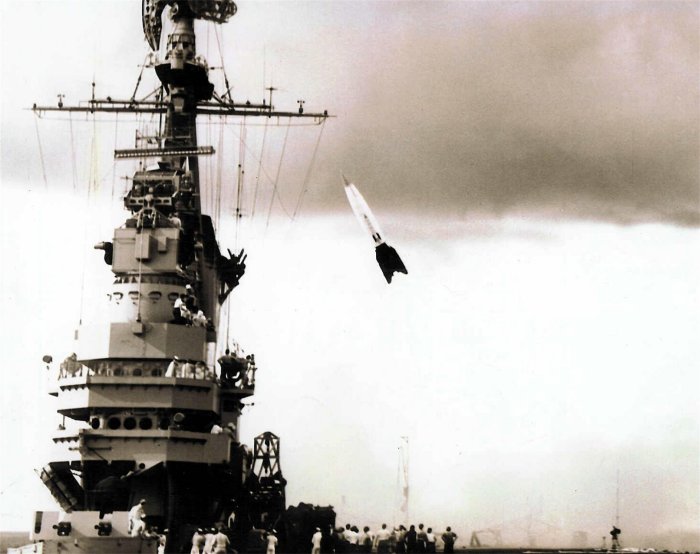Operation Sandy was a groundbreaking event in the history of military technology and rocketry, conducted by the United States Navy in 1947.

This operation involved the remarkable feat of launching a V-2 rocket from the deck of the USS Midway, an aircraft carrier.
It marked a significant milestone in post-World War II technology experiments and advancements in missile development.
The V-2 Rocket
Designed by Wernher von Braun and his team, it was the world’s first long-range guided ballistic missile.
The V-2 was a substantial leap forward in aerospace technology, being the first man-made object to cross the boundary of space.
Standing at 14 meters tall and powered by a liquid-propellant rocket engine, the V-2 could carry a 1,000 kg warhead up to 300 kilometers away at supersonic speeds.
Its design and technology were revolutionary for the time, laying the groundwork for modern rocketry.
Following the war, both the United States and the Soviet Union seized various V-2 rockets and related technological materials.
These were used as foundational elements for their own burgeoning missile and space exploration programs.
 One of the V-2 rockets being prepared to be loaded onto the Midway.
One of the V-2 rockets being prepared to be loaded onto the Midway.The main aim of Operation Sandy was to test the feasibility of launching large-scale rockets from naval vessels, particularly aircraft carriers.
This had far-reaching implications for military strategy, potentially allowing for mobile launch platforms that could be strategically positioned.
Preparations For The Operation
In just a few weeks, a specialized team of officers and enlisted personnel from the USS Midway journeyed to White Sands for comprehensive training in managing and launching a V-2 rocket.
The Army’s ordnance department received instructions to supply two operational V-2 rockets for the test and an additional non-functional model for ongoing training on the ship.
The scheduled date for the Midway’s V-2 rocket launch was determined to be September 6, 1947. One of the rockets on the deck of the Midway during the lead up to Operation Sandy.
One of the rockets on the deck of the Midway during the lead up to Operation Sandy.
By August of that year, the Midway crew had completed their training, and efforts were underway to transport the rockets and necessary equipment to the East Coast.
The USS Midway was docked at the Norfolk Naval Shipyard, conveniently located near the railway lines and cranes essential for loading the V-2 rockets onto the vessel.
On September 2, with all equipment securely on board and final preparations in place, the Midway, accompanied by four Navy destroyers, set sail towards a designated area about 250 miles south of Bermuda for the historic launch.
Operation Sandy
On September 6, at 3:53 p.m., the V-2 rocket was launched. However, just two seconds into the launch, it unexpectedly veered 45 degrees starboard, heading towards the direction of the USS Midway’s flight deck island.
Quickly, the V-2 corrected itself, returning to a vertical position and continuing its ascent normally.
But soon after, the rocket’s flight became unstable, leading to a loss of control. It disintegrated at an altitude of about 12,000 feet.
The rocket broke into three primary pieces, plummeting into the sea a little over three miles from the Midway. The rocket got eerily close to the Midway’s island during the launch.
The rocket got eerily close to the Midway’s island during the launch.
Despite not achieving the intended trajectory, the test was still deemed successful, meeting the primary goals set for the experiment.
Advertisement





